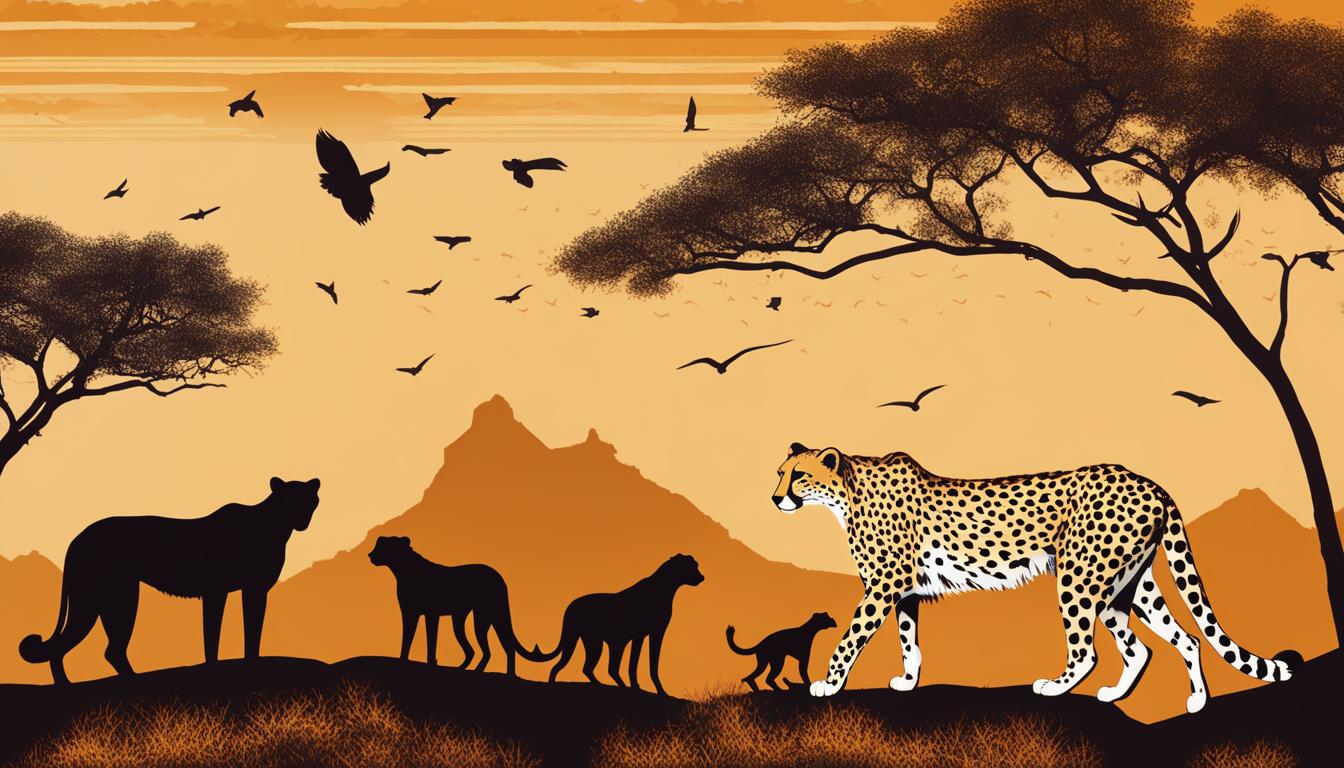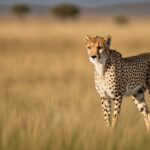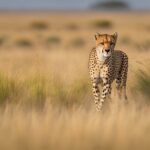The cheetah population size has been a topic of concern in recent years. It is important to understand the cheetah population trends and the status of the global cheetah population. According to a recent study, the cheetah population has declined by 50% in the last four decades. Today, there are only an estimated 7,100 cheetahs left in the wild, down from 14,000 in 1975.
The Challenges Facing Cheetah Conservation
The cheetah population is facing numerous challenges that are contributing to its decline and endangered status. These challenges include habitat loss, poaching, conflict with humans, and the impact of climate change.
Habitat loss is a major threat to cheetahs as wild spaces are being converted for agriculture and livestock. This not only reduces the available habitat for cheetahs but also increases the likelihood of conflict with humans. Farmers often view cheetahs as a threat to their livestock and kill them as a result.
Poaching is another significant threat to cheetahs, with their skin and body parts being in high demand in illegal wildlife trade. This illegal poaching further contributes to the decline of the cheetah population.
Climate change is also impacting cheetah habitats and prey availability. Changes in temperature and rainfall patterns affect the availability of suitable habitats for cheetahs, as well as their prey populations. This disrupts the delicate ecological balance that cheetahs rely on for their survival.
“The challenges facing cheetah conservation are multifaceted and require a comprehensive approach. We need to address habitat loss, implement effective anti-poaching measures, promote coexistence between humans and cheetahs, and actively work towards mitigating the effects of climate change on cheetah habitats.”
The Challenges Facing Cheetah Conservation
| Challenges | Impact |
|---|---|
| Habitat Loss | Reduces available habitat for cheetahs and increases conflict with humans. |
| Poaching | Threatens cheetah population through illegal wildlife trade. |
| Conflict with Humans | Farmers often view cheetahs as a threat to livestock and kill them as a result. |
| Climate Change | Impacts cheetah habitats and prey availability, disrupting their survival. |
Addressing these challenges requires collaboration between conservation organizations, governments, local communities, and individuals. Efforts should focus on habitat preservation, implementing effective anti-poaching measures, promoting coexistence between humans and cheetahs, and supporting initiatives to mitigate the effects of climate change on cheetah habitats.
By raising awareness and actively participating in cheetah conservation efforts, we can make a difference in protecting this magnificent species and ensuring their survival for future generations.
The Genetic Vulnerability of Cheetahs
Cheetahs possess a unique genetic vulnerability that makes them particularly susceptible to environmental changes and diseases. Their low genetic variability, resulting from past population bottlenecks, has left them with limited genetic diversity. This lack of variability poses significant challenges to their ability to adapt to changes in their environment and increases their risk of extinction.
Genetic bottlenecks occur when a population undergoes a severe reduction in numbers, leading to a loss of genetic variation. Cheetahs have experienced two significant bottleneck events in their history, which have further exacerbated their genetic vulnerability. The first bottleneck occurred around 10,000 years ago, reducing the global cheetah population to a small number of individuals. The second bottleneck took place in the early 20th century, which further restricted the genetic diversity of cheetahs.
As a result of these bottlenecks, cheetahs now have a limited gene pool, making them more susceptible to diseases, reproductive problems, and other genetic disorders. This vulnerability is a significant concern for their long-term survival, as it hinders their ability to adapt to changing environmental conditions and increases their susceptibility to infectious diseases, such as feline infectious peritonitis (FIP). The genetic vulnerability of cheetahs highlights the urgent need for conservation efforts to protect and preserve their dwindling populations.
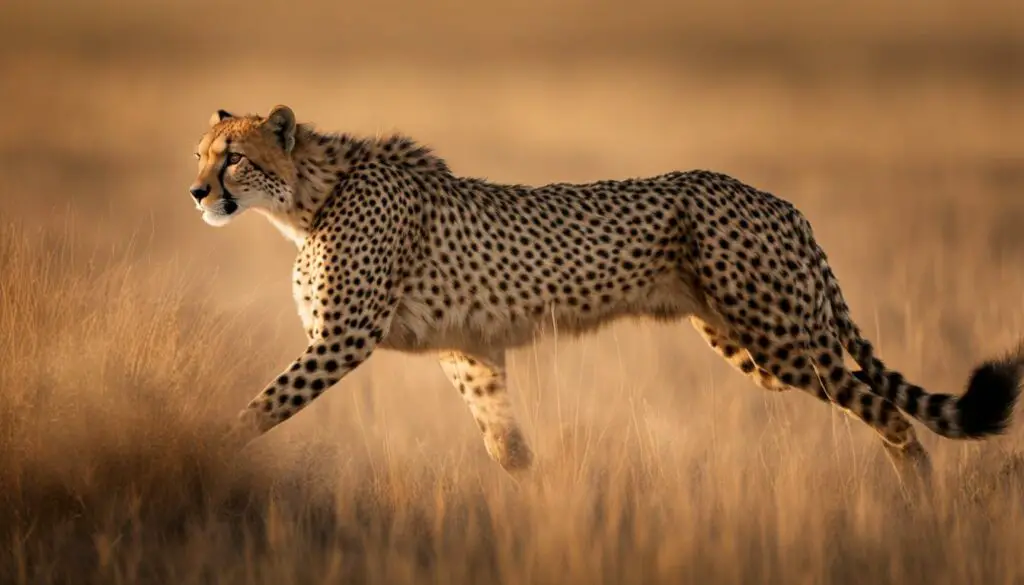
The Impact of Genetic Vulnerability
The genetic vulnerability of cheetahs has far-reaching consequences for their survival. With limited genetic variability, cheetahs are more prone to the effects of inbreeding, which can lead to reduced fertility and increased susceptibility to diseases. Inbreeding depression occurs when individuals inherit two copies of harmful recessive alleles, resulting in reduced fitness and survival rates.
Furthermore, the limited genetic diversity of cheetahs makes it challenging for them to adapt to changing environments and cope with new threats. Without the necessary genetic variability, cheetah populations are less equipped to respond to habitat degradation, climate change, and other challenges. This vulnerability increases the risk of local extinctions and reduces the overall resilience of the species.
To mitigate the genetic vulnerability of cheetahs, conservation efforts focus on maintaining and enhancing genetic diversity within populations. Initiatives such as captive breeding programs and genetic management plans aim to ensure that cheetah populations have access to diverse genetic lineages. By carefully managing breeding programs and facilitating genetic exchanges between different populations, conservationists can help minimize the impact of genetic vulnerability and increase the long-term survival prospects of cheetahs.
The Current Status of the Cheetah Population
The latest census indicates that there are approximately 7,100 cheetahs left in the wild. This population is considered vulnerable and at risk of further decline. The cheetah’s historic range has been significantly reduced, with the species now primarily found in six African countries. In Asia, there are fewer than 50 remaining Asiatic cheetahs.
Cheetah population statistics highlight the urgent need for conservation efforts to protect these magnificent creatures. By understanding the current status of the cheetah population, we can better prioritize conservation actions and raise awareness about the threats they face.
Table: Cheetah Population by Country
| Country | Estimated Cheetah Population |
|---|---|
| Botswana | 1,500 |
| Namibia | 1,200 |
| South Africa | 550 |
| Zimbabwe | 400 |
| Kenya | 300 |
| Iran | 20-50 |
The table provides an overview of the cheetah population by country, highlighting the countries with the largest populations. Botswana and Namibia are home to the highest number of cheetahs, with approximately 1,500 and 1,200 individuals respectively. However, it’s important to note that these numbers are estimates and may vary due to the challenges of accurately counting cheetahs in the wild.
Conservation efforts focused on protecting the remaining cheetah populations are crucial. By working together to address habitat loss, poaching, and other threats, we can ensure the survival of these endangered cheetahs for generations to come.
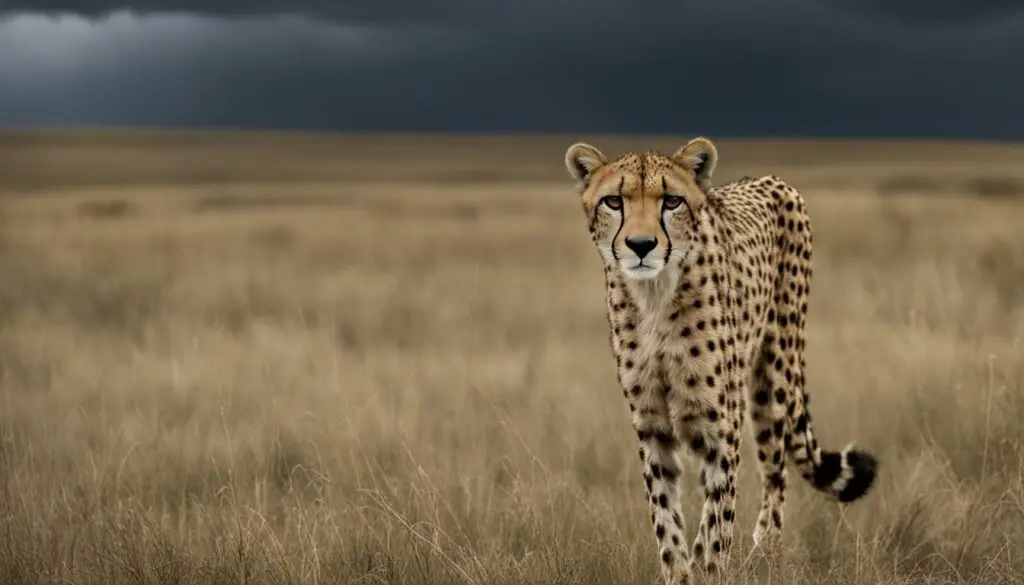
The Main Threats to Cheetahs
Cheetahs are facing numerous threats that are contributing to their population decline. These threats include habitat loss, poaching, conflict with humans, and climate change. Each of these factors plays a significant role in the challenges faced by cheetah conservation efforts.
Habitat loss is a major concern for cheetahs. As human populations grow, wild spaces are being converted for agriculture and livestock, resulting in the destruction of their habitats. This loss of habitat not only reduces the available space for cheetahs to roam and find prey but also increases the likelihood of conflict with humans as they compete for resources.
Poaching is another significant threat to cheetah populations. These magnificent animals are targeted for their skins and body parts, which are highly valued on the illegal wildlife trade market. The demand for these products drives the illegal hunting and killing of cheetahs, putting further pressure on their already vulnerable population.
Additionally, climate change is impacting cheetah habitats and prey availability. Changes in weather patterns, droughts, and shifts in vegetation can disrupt the delicate balance of ecosystems, affecting the cheetahs’ ability to find food and survive. The loss of prey due to climate change can lead to increased competition among cheetahs, further jeopardizing their survival.
Table: The Main Threats to Cheetahs
| Threat | Description |
|---|---|
| Habitat Loss | Conversion of wild spaces for agriculture and livestock, reducing available cheetah habitats and increasing competition with humans. |
| Poaching | Illegal hunting and killing of cheetahs for their skins and body parts, driven by the demand in the illegal wildlife trade market. |
| Conflict with Humans | Competition for resources with human populations, leading to the killing of cheetahs to protect livestock or due to fear and misunderstanding. |
| Climate Change | Disruption of ecosystems, changes in weather patterns, and shifts in vegetation impacting cheetah habitats and prey availability. |
Efforts are being made by conservation organizations and governments to address these threats and protect cheetah populations. These include initiatives focused on habitat preservation, anti-poaching measures, and community engagement. By raising awareness, implementing conservation strategies, and promoting sustainable practices, we can work towards ensuring the survival of these magnificent and endangered creatures.
Conclusion
The cheetah population is currently in a critical state, with only around 7,100 individuals remaining in the wild. This decline is primarily due to habitat loss, hunting, and climate change. However, there are ongoing efforts to protect and conserve these magnificent creatures.
Habitat preservation plays a crucial role in cheetah conservation. By safeguarding their natural habitats, we can ensure that these animals have the necessary resources to thrive. Anti-poaching measures are also essential in curbing the illegal hunting of cheetahs for their skin and body parts, which has contributed to their population decline. Additionally, engaging local communities in conservation initiatives is key to fostering a sense of stewardship and encouraging sustainable practices.
To protect the cheetah population, it is crucial that we raise awareness about their plight and the importance of their conservation. By supporting organizations and initiatives focused on cheetah protection, we can contribute to the long-term survival of these incredible animals. It is our collective responsibility to ensure that future generations have the opportunity to witness the beauty and grace of the cheetah in the wild.
Are the Remaining Cheetahs in the Wild Concentrated in Specific Geographic Locations?
Yes, the remaining cheetahs in the wild locations are concentrated in specific geographic areas such as East and Southern Africa. These regions provide the ideal habitat for the cheetahs, with open grasslands and savannas allowing them to thrive. However, their population is still at risk due to habitat loss and human-wildlife conflict.
– Can the dwindling population of cheetahs in the wild be attributed to their natural predators?
The dwindling population of cheetahs in the wild cannot solely be attributed to their natural predators. While other species such as lions and hyenas are indeed natural predators of cheetahs, factors like habitat loss and human conflict play a significant role in their declining numbers.
FAQ
How many cheetahs are left in the wild?
According to recent studies, there are approximately 7,100 cheetahs left in the wild.
What are the challenges facing cheetah conservation?
Cheetahs face challenges such as habitat loss, hunting by humans, and climate change.
What is the genetic vulnerability of cheetahs?
Cheetahs have low genetic variability, making them susceptible to environmental changes and diseases.
What is the current status of the cheetah population?
The cheetah population is considered vulnerable, with approximately 7,100 individuals remaining in the wild.
What are the main threats to cheetahs?
The main threats to cheetahs include habitat loss, poaching, conflict with humans, and climate change.
What efforts are being made to protect cheetahs?
Conservation organizations are working on initiatives such as habitat preservation, anti-poaching efforts, and community engagement.

